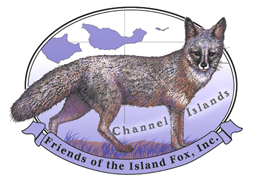Fox Festival - Oct. 2
Join us at an UPCOMING EVENT:
Sunday, October 2, Friends of the Island Fox, Inc. will be at :
The Santa Barbara Zoo is one of the few places beyond the Channel Islands where you can see an endangered island fox. The island foxes at the Santa Barbara Zoo were the first to breed in captivity on the main land and the zoo has been very involved with the National Park Service and the Nature Conservancy regarding captive fox husbandry on the islands.
What can you do to help the island fox?
All Fall Fox Festival activities are included with the price of Zoo admission.
Come out and join us Sunday, October 2 (11 AM - 3 PM) and MEET AN ISLAND FOX.
Sunday, October 2, Friends of the Island Fox, Inc. will be at :
The Fall Fox Festival at the Santa Barbara Zoo
The Santa Barbara Zoo is one of the few places beyond the Channel Islands where you can see an endangered island fox. The island foxes at the Santa Barbara Zoo were the first to breed in captivity on the main land and the zoo has been very involved with the National Park Service and the Nature Conservancy regarding captive fox husbandry on the islands.
- Come and see the island foxes enjoy some of their favorite food–insects.
- Learn about the challenges the fox faces in the wild.
- And have fun with fox crafts, face painting, and other activities.
What can you do to help the island fox?
- Friends of the Island Fox will be raising money to provide funds for fox radio collars. Each island fox returned to the wild on San Miguel, Santa Rosa, and Santa Cruz Island must have a radio collar so biologists can monitor its activity and survival. Radio collars cost $250.00 each. Every little bit we raise will help to see that another island fox can be released back into the wild.
- You also can be an ambassador. The more you know about the Channel Islands and the island fox, the more you can spread the story and help us Save The Island Fox.
All Fall Fox Festival activities are included with the price of Zoo admission.
Come out and join us Sunday, October 2 (11 AM - 3 PM) and MEET AN ISLAND FOX.


